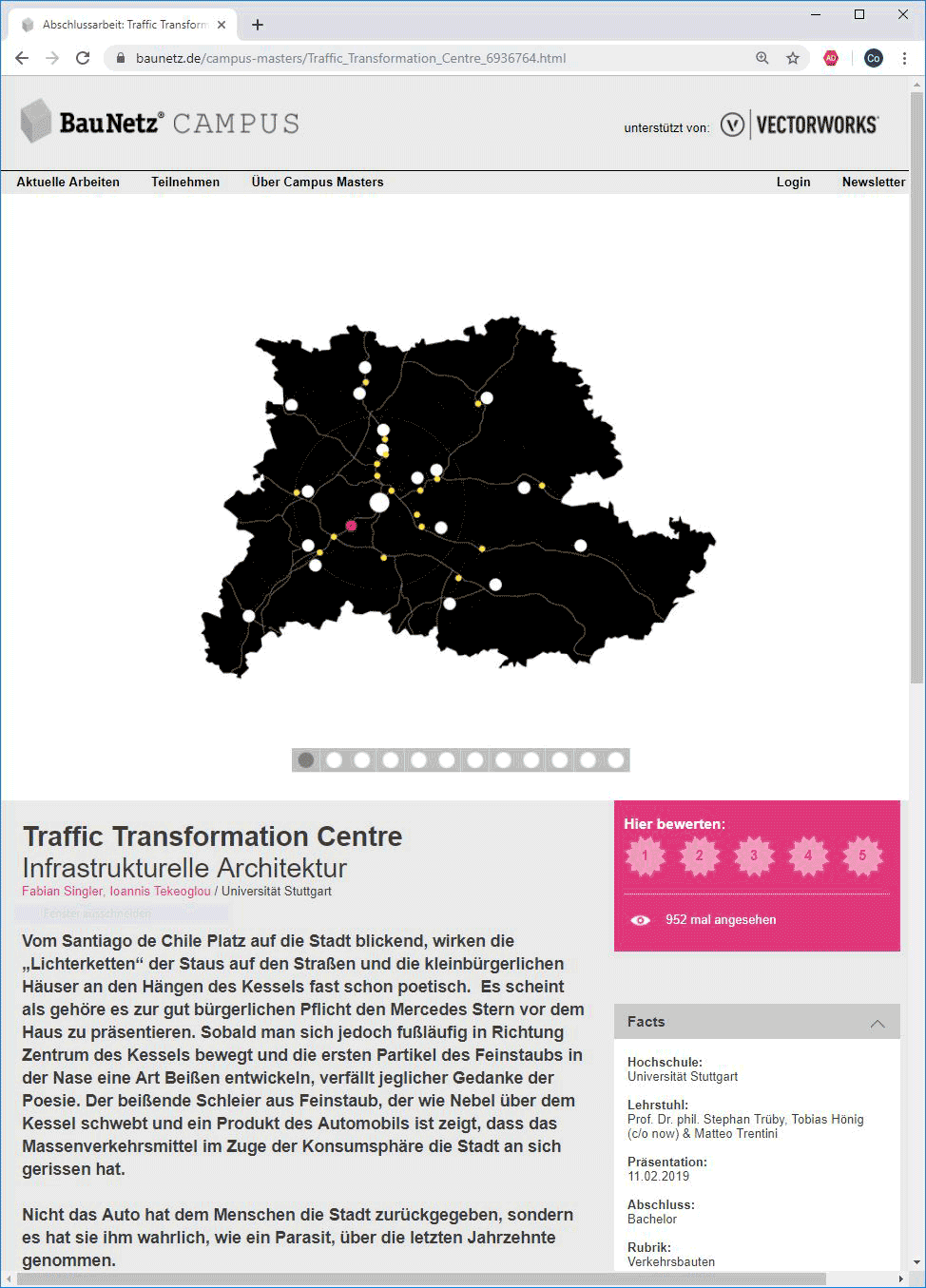- Typology
- Research
- Project
- c/o now c/o IGMA 024
- year
- 2018 - 2021
- Location
- Institut Grundlagen moderner Architektur & Entwerfen (IGMA), Fakultät für Architektur, Technische Universität, Stuttgart, Baden-Württemberg, Deutschland
- Since 2018 Tobias Hönig for c/o now serves as a team member at the Institute for Principles of Modern Architecture, Cultural Theory and Design (IGMA) at the Department of Architecture & Town Planning at the University of Stuttgart. He together with Matteo Trentini is in charge of one of the institute's 2 design studios (Studio II: Iassen Markov).
- professor
- Stephan Trüby
- assistant professors
- Verena Hartbaum (2018 -), Tobias Hönig (c/o now, 2018 -), Iassen Markov (Universitoy of looking good, 2018 -), Sandra Oehy (2018 -), Zsuzsanna Stánitz (2018 -), Matteo Trentini (2018 -)
- office
- Andrea Röck & Erika Ortiz de Harle
- students
- Martina Bodinka, Sylvia Brüstle, Gabriela Silva Correa, Tatiana Darnovsky, Philipp Deilmann, Eva Hannewinckel, Joscha Heitz, Franziska Mack, Marie Müller, Alexander Nägele, Erika Nikolova, Zion Okra, Nicole Ottmann, Johannes Pojtinger, Gabriel Rihaczek, Johannes Rinderknecht, Eric Schanck, Amelie Vogginger, Magdalena von Fritsch, Philipp Wurster
- special thanks
- Inge Graze, Marion & Hannes Kern
![IGMA Logo]() 024
024
Fig.002https://www.igma.uni-stuttgart.de/
© IGMA
![]() 024
024
Fig.___Studio Hönig & Trentini /// WS18/19 /// Fabian Singler & Ioannis Tekeoglou: "Traffic Transformation Centre"
© Fabian Singler & Ioannis Tekeoglou
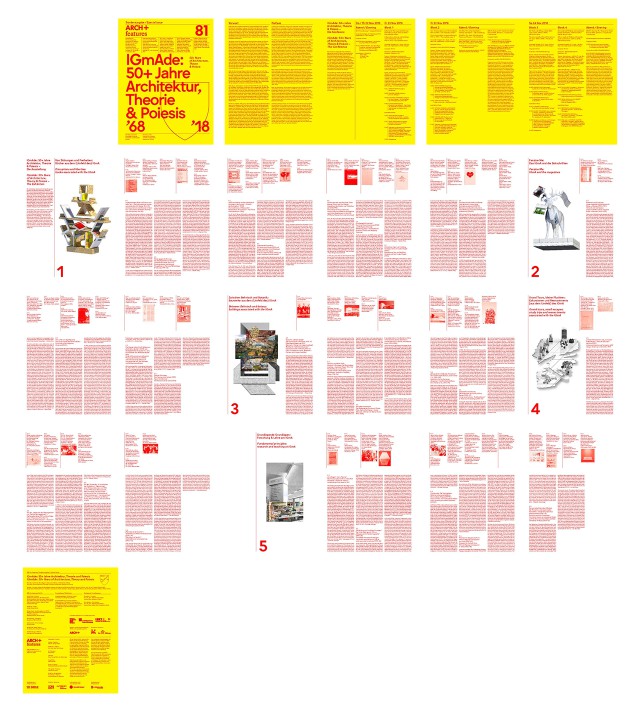 024
024
Fig.___In 2018, the architecture community celebrates the 50th anniversary of the Institute for Principles of Modern Architecture (Design and Theory) (IGmA), the first and largest institute for architectural theory and design in Germany. On the occasion of this anniversary, the University of Stuttgart is hosting an international conference on architectural theory from 22 to 24 November 2018 entitled IGmAde – 50+ Years of Architecture, Theory and Poiesis. In cooperation with the Württembergischer Kunstverein, the eponymous anniversary exhibition will open on the evening of 23 November 2018.
The IGmA was founded in 1967 in answer to the prevailing anti-theoretical stance of modernism paralyzed by dogma, and in the revolutionary year of 1968 launched its regular teaching operations. Its founder, Jürgen Joedicke, was head of the institute for more than a quarter of a century, from 1967 to 1993. During his tenure, the institute came to prominence by focusing not only on the history of modern architecture and interpretations of contemporary architecture, but also on the theoretical foundations of architecture and their implementation in practice. The two publication series – Dokumente der modernen Architektur (Documents of Modern Architecture, published by Karl Krämer Verlag in 14 volumes, 1961–81) and Arbeitsberichte zur Planungsmethodik (Proceedings on Planning Methodology, published in 9 volumes, 1969–75) – bear witness to this orientation. From the very start, the institute dedicated itself to contemporary issues, such as the potential of planning theory and user participation, and the relevance of the historical city. At the IGmA, the combination of design theory and theoretical reflection was a program in itself. This trained the contextual thinking of the students, who were encouraged to direct their attention and actions to the question: How do we want to live and what urban environment do we want?
After Jürgen Joedicke’s retirement, Werner Durth became the new director of the institute, and from 1993 to 1998 continued his research on the historical relationship between tradition and modernism. During this period, an important, though subtle, change was made to the institute’s German name, so that “principles of the modern architecture” became “principles of modern architecture.” Especially given the fall of the Berlin Wall and the unification of East and West Germany, it was more than understandable that “modern architecture” could only be thought of in its plural form. Durth’s IGmA research is documented in the two-volume publication Architektur und Städtebau der DDR (Architecture and Urban Planning in the GDR; 1998).
After an interregnum, during which a symposium for the 30th anniversary of the IGmA was held in the winter of 1998/99 under the direction of Wolfgang Schwinge, Gerd de Bruyn served as head of the institute from 2001 to 2018. Under de Bruyn, the IGmA continued to live up to its special role as an interdisciplinary institute that extends and transcends the conventional boundaries of architecture, one particularly dedicated to teaching theory, art, technology, and the natural and cultural sciences. In addition, de Bruyn dealt with phenomena such as fashion and new media, the analysis of the scientific nature of architecture, and building with living plants (biotechnical design).
Initiated by Stephan Trüby, the new director of the IGmA since April 2018, the exhibition and conference now aim to provide new insights into 50 exciting years of architecture and the IGmA, which are not least about the entanglements and distances between theory and design, and accordingly, the notion of practice. In his Nicomachean Ethics, Aristotle writes that practice is action that finds its purpose in itself. He contrasts this with “poiesis,” an action whose purpose exists independent of and beyond the action. Only poiesis culminates in artifacts and buildings, not practice. For this reason, when we speak of buildings, we prefer to speak of the poiesis – not the practice – of architecture. And by extension, we use the word “poietics” to refer to all the books, magazines, buildings, excursions, travelogues, research papers, and courses that have come into being over the last half-century at or in the context of the IGmA. As such, they invite us to reflect upon them as “ig-made artifacts.”
© ARCH+
- 024
Gif.___© c/o now
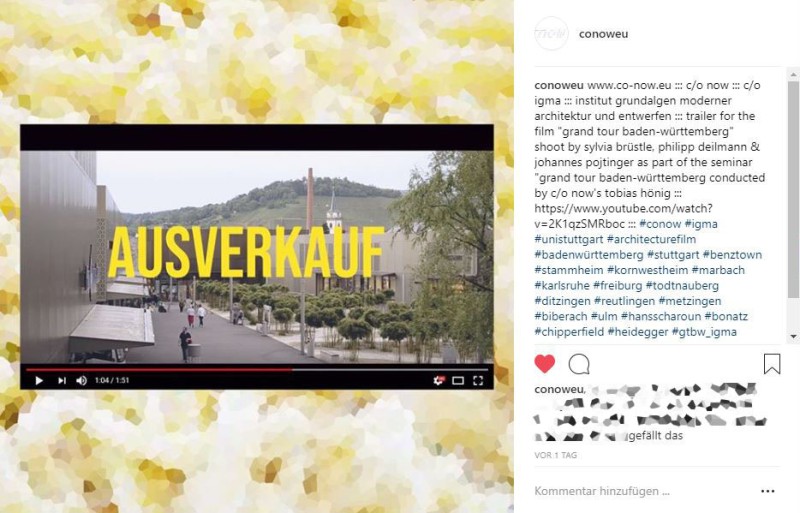 024
024
Fig.___https://www.youtube.com/watch?v=2K1qzSMRboc
© Sylvia Brüstle, Philipp Deilmann, Johannes Pojtinger & Institut Grundlagen moderner Architektur und Entwerfen
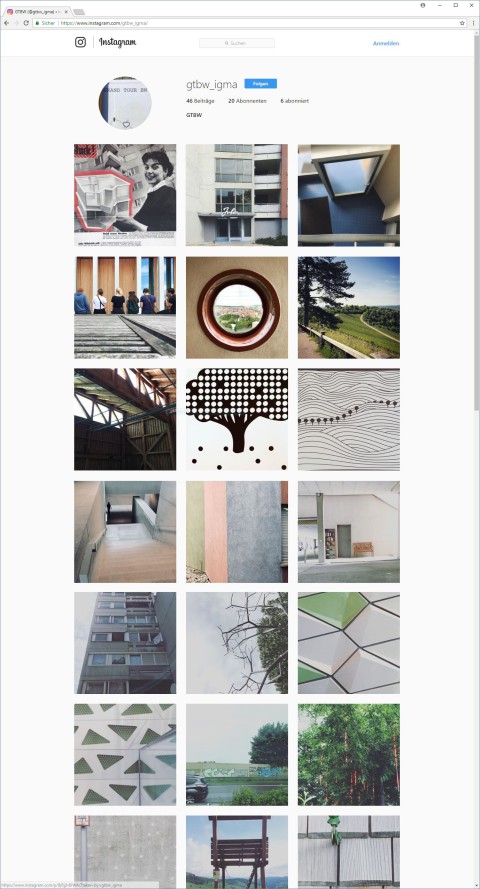 024
024
Fig.005...the student's very own Instagram-account dedicated to the GTBW_IGMA: https://www.instagram.com/gtbw_igma/
Instagram
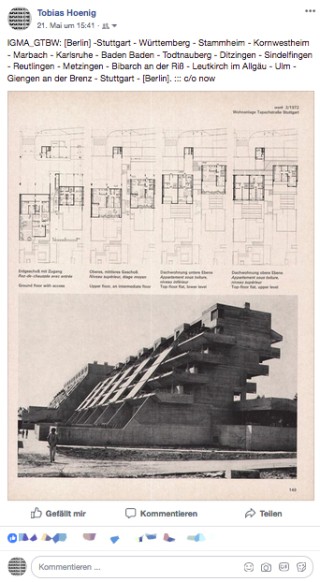 024
024
Fig.004tour schedule GTBW_IGMA according to c/o now
facebook
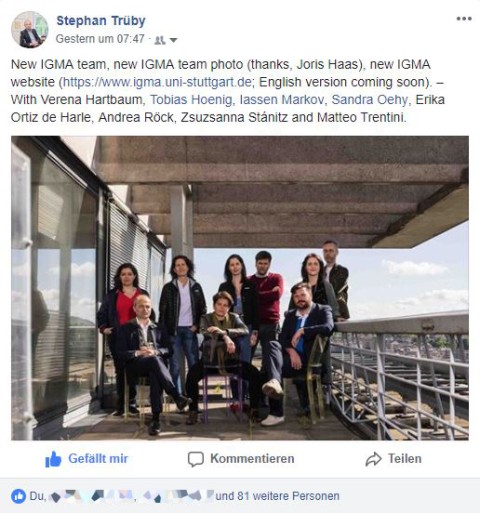 024
024
Fig.003In April 2018 IGMA undergoes a complete re-boot with not only a new director but also a entire new team. From left to right: Erika Ortiz de Harle, Stephan Trüby, Andrea Röck, Verena Hartbaum, Zsuzsanna Stánitz, Matteo Trentini, Tobias Hönig (c/o now), Sandra Oehy & Iassen Markov.
facebook
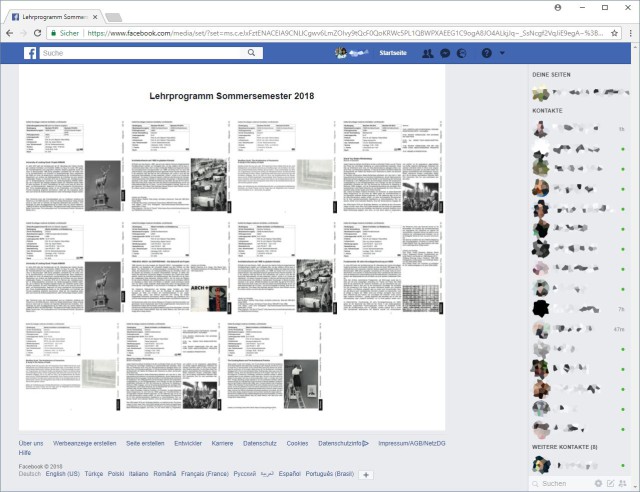 024
024
Fig.001Summer term 2018
Grand Tour Baden-Württemberg
Tobias Hönig (c/o now & IGMA)
Jürgen Habermas defines modernity as the unfinished project to derive a practice of reasonably shaping living conditions from theory. This idea, says Habermas, is constantly endangered by an alliance of post- and pre-modernism carried by (neo-)conservatism. In the field of architecture Habermas identifies the willingness to sacrifice the tradition of modernism in favour of historicism as a symptom of this tension.
After the Second World War numerous architectures and spatial constellations emerge in the historical conservative Baden-Württemberg that meet Habermas’ description. The conflict over the closing of the HfG in Ulm (1968) is commonly considered as an confrontation between the conservative state government of prime minister Hans Filbinger and the staff of the HfG committed to modernism. The foundation of the HfG in Karlsruhe (1992) on the contrary, is understood as concession of the then prime minister Lothar Späth, who, as a secretary of state, had to liquidate the Ulm school and who later recognized this as a big failure.
facebook
After the retirement of Gerd de Bruyn the Institute for Principles of Modern Architecture, Cultural Theory and Design (IGMA) at the University Stuttgart experiences a total reboot. Not only does Stephan Trüby take charge of the institute, he also brings along a whole new team, in which c/o now is represented by Tobias Hönig. In 2018 Stuttgart is celebrating many anniversaries, some of them crucial to an institute obliged to modern architecture: 50 years '68, the 50th anniversary of the legendary Bauhaus-retrospective in Stuttgart, 50 years ago the HfG Ulm was closed and - last but not least - the IGMA itself will be 50.
Not only to evaluate the state of modernism in Baden-Württemberg together with the students, but also to allow the many in the team who do not origin from the southwestern federal province a sort of a "moon landing", c/o now contributes a Grand Tour - the GTBW_IGMA - to the teaching program in the first turn of the new institute.

